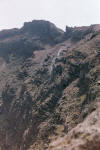All the
photographs on these pages are free for you to access and use. Click on a thumbnail
to see the picture full size. The photograph will open up in a separate window.
If you are using MS Internet Explorer you can
download a picture to your own computer by right clicking on it and choosing Save
picture as.... If you are using a different browser the method may be different.
All the photos in the ICTeachers
Photo Library have been freely given by the photographers, who retain ownership of them.
You may use them as long as:
you do not charge for them;
you acknowledge their source.
| All
the photographs on this page are by Mike Freedman. |
| |
| |
 |
 |
 |
 |
 |
|
Looking down into the crater. The crater
is around 700 metres across. The
surface outside is very cindery. In the far wall you can see that
the crater rim is made of layers of rock. Vesuvius is a cinder cone,
made up of layers of cinders and solidified lava. |
The cone of Mt. Vesuvius rises inside
the remains of the caldera of Mt Somma. This, much older volcano
collapsed around 17,000 years ago. Mt Somma has given its name to
the phenomenon of volcanoes inside larger, older calderae, which are
known as somma-type volcanoes. Mt Somma is much
larger and rather lower than Vesuvius itself. Trees grow on the older
surface but very little has begun to grow on the lava flow from the
latest eruption in 1944, which stretches around the bottom of the
crater rim. These two photos show the inside of the rim of Mt Somma.
You can clearly see the car park and gift shop as well as the
footpath snaking up to the crater rim of Vesuvius itself. |
Although Vesuvius is an active volcano,
it has been quiet since 1944. This picture shows a column of steam
rising form a fumarole just inside the crater rim. |
|
190Kb |
188Kb |
172Kb |
177Kb |
190Kb |
| |
 |
|
|
|
|
This view from the top of Vesuvius is
looking across towards Naples, which it is just possible to make out
through the haze, beyond the wooded lower slopes.
In the foreground you can see clouds rolling in across the cindery
surface of the cone. |
|
|
|
|
|
140Kb |
|
|
|
|
Return to Mountains
| Return to Photo Index |